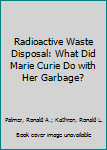Radioactive Waste Disposal: What Did Marie Curie Do with Her Garbage?
The book gives a historical, interdisciplinary, and theoreticaldiscussion on management of radioactive waste. Chronicling thelifetime achievements of Marie Curie, the book seeks to informreaders what radioactive waste is, where it comes from, and how wecame to our current state of affairs. The book discusses the"ever-increasing amounts of waste" as more nuclearpower plants come into use and plans of other nations arediscussed. It covers the development of all of the topicsmentioned throughout the book (e.g. medical, low level wastes, TRUwastes, and high level waste from nuclear fuel reprocessing) bothfrom a technological and scientific standpoint as well as politicaland public acceptance). Topics such as "radiation hazardsincluding radiotoxicity of various radionuclides in radioactivewaste as a basis for determining radioactive waste managementstandards and practices, as well as the various types ofradioactive wastes are addressed. Regulations of radioactivewastes by various countries and on an international level areincluded as well. An Afterword discusses alternative pastsand futures. The book strives to present possible solutions tolingering questions: What might have been done during the pasthundred years? What choices do we have now? What arethe possibilities of doing the right thing, whatever that is? Is there either technical or political leadership available tocreate a safe and sustainable ending? The book contributes to theintelligent discussion of complex problems our society must resolveas we enter the 21st Century.
Format:Hardcover
Language:English
ISBN:1119137128
ISBN13:9781119137122
Release Date:December 2023
Publisher:Wiley-American Ceramic Society
Length:300 Pages
Customer Reviews
0 rating





